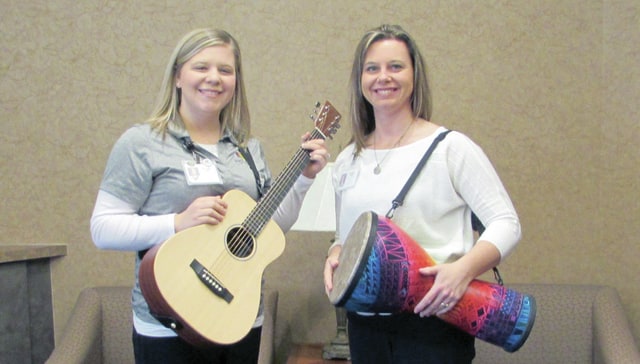
GREENVILLE — Music Therapist is a title that is earned.
“Just because someone plays guitar and sings, doesn’t make them a music therapist,” Amy Pearson said.
Pearson and Ashlee Slavin are Board-Certified Music Therapists at the non-profit State of the Heart Care in Greenville, Ohio. In its 35th year, State of the Art provides an integrated approach to end-of-life care in the 12 counties of both its Ohio and Indiana agencies. The agency offers physicians, nurse practitioners, Registered Nurses, Licensed Practical Nurses, aides, licensed Social Workers, bereavement support specialists, volunteers, chaplains, office staff and Board-Certified Music Therapists.
“The music reaches a part of the brain that is unstimulated by other things,” Slavin said. “Sometimes it actually helps control the sensory input for people. Maybe receiving physical touch might be too much for some, but the music can help calm and relax them in a different way, without being too invasive.”
According to the American Music Therapy Association, Music Therapy is the clinical and evidence-based use of music interventions to accomplish individualized goals within a therapeutic relationship by a credentialed professional, who has completed an approved Music Therapy program. It is using music to help people attain non-musical goals, Pearson said. It is another way to connect with people.
Board-Certified Music Therapists receive extensive training in a combination of psychology and musical disciplines. In addition to the required schooling, they have at least six months of internships, board exams and continuing education. In order to graduate, one has to be proficient in guitar, piano, voice, percussion and another primary instrument. They both play the flute.
According to Pearson, State of the Heart has employed music therapists for about 12 years. Pearson has been there for 10. Patients admitted into State of the Heart are offered all of their services, but are not required to accept them all. Music Therapy can be requested at any time during their care.
“The question is, how can we help hospice patients using music?” Pearson said.
Those in hospice are of any age, facing a terminal diagnosis determined by a physician to live six months or less. Some patients are there for longer periods of time.
“As long as they continue to show a decline, they can receive hospice services,” Pearson said.
“For us it is not always sad and heavy,” Slavin said.
“We bring quality, not quantity of life to them,” Pearson added. “Creating a moment together with the family that they will always remember makes our job really neat.”
Some patients seek out State of the Heart because they offer Music Therapy. For those patients feeling pain, in addition to medication, the music acts as a distraction that helps the brain focus on something else, Slavin said.
“It is a great combination to help them relax,” she added. “Sometimes the pain medicine alone just doesn’t cut it. It can also help regulate breathing. If they are having relaxed breathing, in turn it will help relax their body and it continues on a cycle to help them relax.”
Musical Therapy is a job that is often misunderstood, according to Slavin. Some people think the same result can come from turning on a CD player.
“We fight that all the time,” she said. “ You can’t do physical therapy by watching an exercise video. It is so much more than listening to music.”
Slavin and Pearson typically sing and play guitar. In their initial assessment, the choice of music depends on the patient. If the patient is unable to request a song, music is sometimes chosen by family members. If no suggestions are made, the obvious choice is music from their generation, according to Slavin.
“The teens to the early twenties is the time when people are really forming who they are,” she said.
“That’s your identity, so you really connect with that music,” Pearson added.
For patients who are verbally uncommunicative, the therapists rely on the the patient’s body language for evaluative feedback.
“Music is really close to the part of the brain that stores your emotional feelings,” Slavin said. “Some patients may have a flat affect when you go to see them and they don’t interact with you very much. They can’t express how they feel inside. But you start playing some of their favorite music and interacting with them musically, and all of a sudden they may become bright, they may smile, they may cry and show emotional expression. That is very powerful for people.”
Pearson saw a study about how music is stored in different places in the brain. Photos of an Alzheimer’s patient’s brain showed gaps.
“That made sense to me. It’s still there for them to access,” Pearson said. “We have seen that over and over, where a patient can’t remember what they had for lunch, or their family members names, but they can remember every word of a song.”
Something new that the therapists offer patients are heartbeat recordings. Using a recordable stethoscope, a patient’s heartbeat is recorded. That sound is recorded, along with one of their favorite songs, onto a CD.
“We have that basic sound of life to give after the patient passes, so they can still hear their loved one’s heart beat,” Pearson said.
Pearson’s love of music and of helping people, made the job choice easy.
“It’s been awesome,” she said. “I like knowing that the work we do is effecting people in a positive way.”
Slavin initially wanted to be a band director and teach kids how to play instruments. She heard about Music Therapy and completed an internship with State of the Heart. She was hired and has been working there for three years.
“I really love it and feel I am supposed to be here,” she said. “If I can help one person feel better or enable them to communicate using music, it is better than teaching 50 kids how to play a trumpet,” she said.
For more information, visit www.stateoftheheartcare.org.





